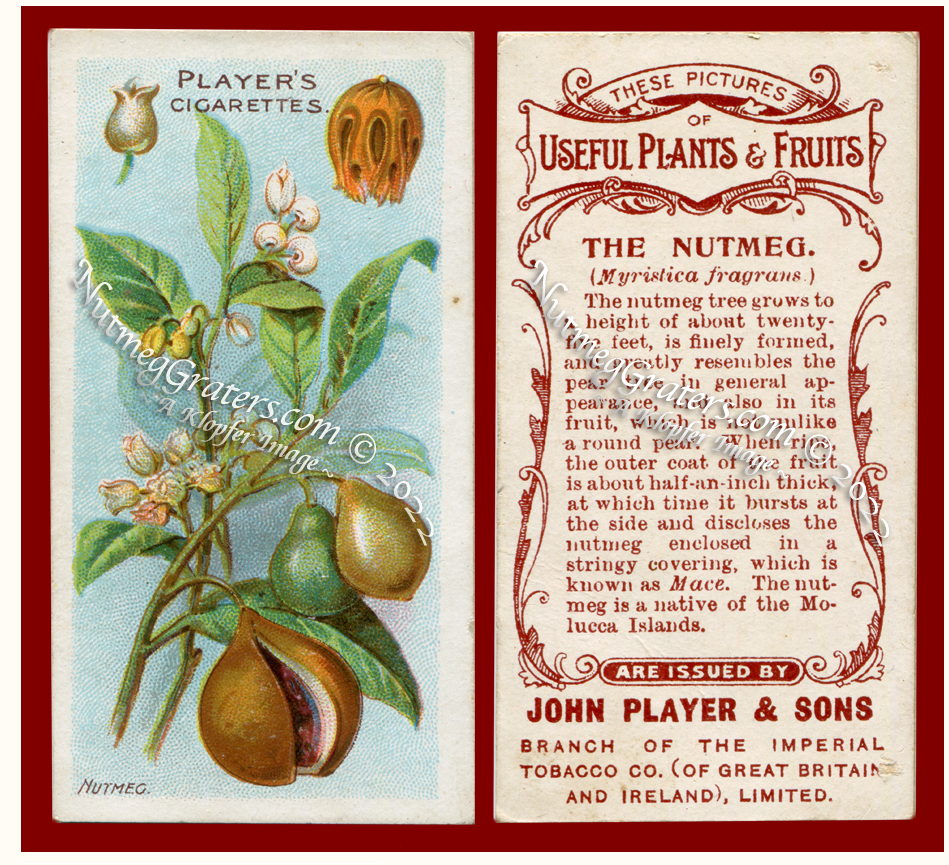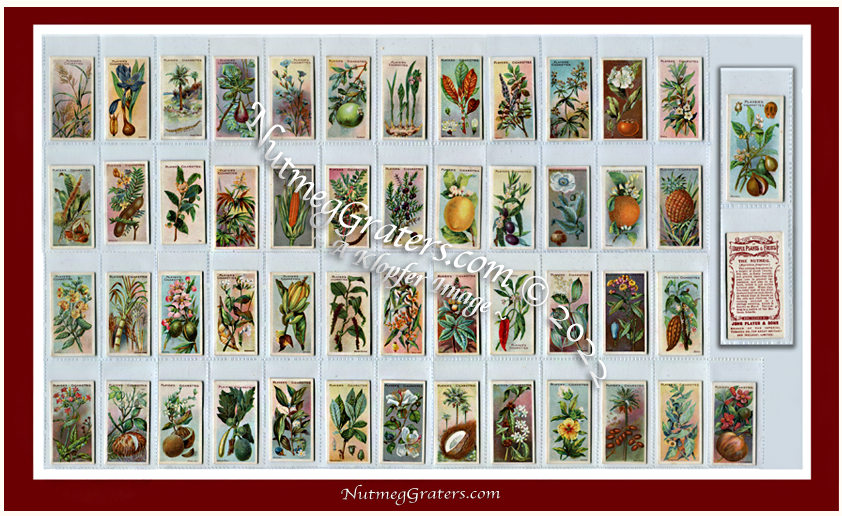NutmegGraters.Com

 "THE NUTMEG. (Myristica fragrans.)" ~ 1902 ~ "These Pictures Of Useful Plants & Fruits" ~ By: John Player & Sons ~ One Card From The Full Set of 50 Trade Insert Cards
"THE NUTMEG. (Myristica fragrans.)" ~ 1902 ~ "These Pictures Of Useful Plants & Fruits" ~ By: John Player & Sons ~ One Card From The Full Set of 50 Trade Insert Cards
PRINT ENTITLED: "THE NUTMEG. (Myristica fragrans)".
SERIES: These Pictures of Useful Plants & Fruits.
DATE OF ISSUE: 1902.
SCOPE & PURPOSE OF PUBLICATION: Promotional
Advertising ~ In the form of Collectible Insert Trade Cards.
PRINT METHOD: Chromolithography
PAPER TYPE: Card Stock (unwater marked).
COLORING: Color Lithograph to include the printed text.
MEASUREMENT: (L) 2.65 inches; (W) 1.4 inches.
PRODUCED FOR: John Player & Sons ~ "PLAYER'S
CIGARETTES".
[NOTE: The featured print (above) is part of the 50 card set (below):

HISTORY: The John Player & Sons Company was one of the earliest cigarette producers to use Cigarette Cards as an inducement to enhance product sales. In 1893, the John Player Company in Radford, Nottingham, England, produced their first sets of Cigarette Cards, ~ "One of the first sets {…} was Castles and Abbeys" [1]. Between 1886 and World War II, Player's Cigarettes produced about 250 sets of cards, usually in sets of 50. Featured here, the John Player & Sons series: THESE PICTURES OF USEFUL PLANTS & FRUITS was produced in 1902. On the face of each card is a plant illustration with its historical usefulness described on the reverse.
It is interesting to note that the "Nutmeg" card's narrative omits to state why this plant was included as "…USEFUL…". At the time of printing (1902), nutmeg had remained listed among medical drugs within pharmaceutical references, yet only two decades later following WWI, nutmeg's status as "useful" was diminished, becoming referenced only as a "flavorant". Additionally of interest, the card's narrative incorrectly states that "The nutmeg tree grows to height of about twenty-five feet…" ~ when factually, the height of the trees vary dependent on the location in which they are cultivated. Trees in their native habitat in the Banda Islands may grow to 75 feet, where in some locations in India or the Caribbean Islands, they only reach 15 feet at maturity. These differences are established dependent on soil and climate.
Between 1886 and World War II, Player's Cigarettes produced about 250 sets of cards, usually in sets of 50. During major wars, this practice was discontinued due to war shortages, and later, due to improvement in commercial packaging. Following WWII, cigarette cards became an outmoded form of advertising, and this custom fell into disuse.
HISTORY OF PROMOTIONAL ADVERTISING INSERT TRADE CARDS ~ CREATED AS AN INCENTIVE COLLECTABLE PREMIUM:
The manufacture of packaged, pre-rolled cigarettes evolved during the last-quarter of the nineteenth century, a product which curtailed the need for individual smokers to hand-roll their own cigarettes ~ thus, resulting in a significant decline in the sale of loose tobaccos. To protect against damage to the delicate packs of cigarettes during transport, cigarette makers began inserting hefty card-stock as reinforcement to fortify the package exteriors. Initially, this card-stock was blank, but as a marketing strategy, an American tobacco firm Goodwin & Co. began in 1886 to print themed picture-sets on the card-stock as an enticement to lure return-customer patronage. Goodwin & Co. produced their illustrated series in amounts of 25 or 50 card sets (and sometimes larger) [2]. Advertising through cigarette cards spread world-wide, and a multitude of series were produced by tobacco companies in North America, South America, Europe, Africa and Australia [2]. Among modern cartophilists, sport themed cigarette cards are the most valuable and are highly collectible.
REFERENCES:
1"Cigarette Cards" John Player & Sons, Wikipedia, (2022)
2 "Cigarette Cards Tell History" American Antiquities Journal, 126 East high Street, Springfield, Ohio 45502 (ND).
[KLOPFER article © May 2022]